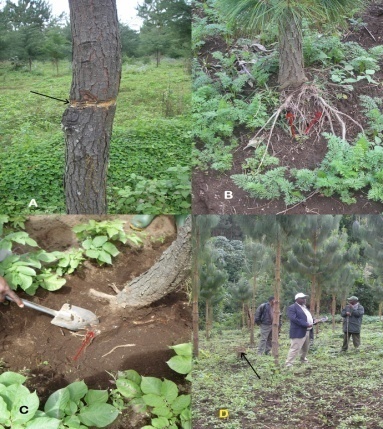-
Paper Information
- Next Paper
- Paper Submission
-
Journal Information
- About This Journal
- Editorial Board
- Current Issue
- Archive
- Author Guidelines
- Contact Us
International Journal of Agriculture and Forestry
p-ISSN: 2165-882X e-ISSN: 2165-8846
2015; 5(5): 267-275
doi:10.5923/j.ijaf.20150505.01
Perils of Taungya to the Productivity of Forest Plantations and Need for Modification: Case Study of Meru Forest Plantation in Tanzania
O. A. Ndomba1, S. Bakengesa2, R. Petro2, J. Maguzu2, S. A. O. Chamshama3, H. R. Kiimu4, M. Lema5
1Tropical Pesticides Research Institute (TPRI), Arusha, Tanzania
2Tanzania Forestry Research Institute (TAFORI), Morogoro, Tanzania
3Sokoine University of Agriculture (SUA), Chuo Kikuu, Morogoro, Tanzania
4Meru Forest Plantation – Olmontony, Arusha Tanzania
5Tanzania Forest Service (TFS), Dar es Salaam, Tanzania
Correspondence to: O. A. Ndomba, Tropical Pesticides Research Institute (TPRI), Arusha, Tanzania.
| Email: |  |
Copyright © 2015 Scientific & Academic Publishing. All Rights Reserved.
Factors affecting productivity of forest plantations were investigated in the Mount Meru natural system in Northern Tanzania. Taungya emerged top in the agenda - it caused inappropriate use of agrochemicals, over pruning of trees, damage to forest trees and encroachment of forestland for farming. Case studies from Thailand, Ghana, Uganda and Kenya are cited to show how similar problems were addressed. In this study, an improvement path is proposed for Meru forest plantation. It strongly urges forestry professionals and local administrators to look at the case studies vis-à-vis proposed improvement path and initiate a high-end consultative process with farming communities and other stakeholders to redress the situation. This is one of the most comprehensive studies regarding taungya practice in Tanzania.
Keywords: Meru plantation, Plantation productivity, Food security, Taungya, Consultation, Tanzania
Cite this paper: O. A. Ndomba, S. Bakengesa, R. Petro, J. Maguzu, S. A. O. Chamshama, H. R. Kiimu, M. Lema, Perils of Taungya to the Productivity of Forest Plantations and Need for Modification: Case Study of Meru Forest Plantation in Tanzania, International Journal of Agriculture and Forestry, Vol. 5 No. 5, 2015, pp. 267-275. doi: 10.5923/j.ijaf.20150505.01.
Article Outline
1. Introduction
- Taungya is a method of planting forest trees in combination with food crops. It has its origins in Southeast Asia (Burma, now Myanmar and Thailand) where it was introduced in a bid to restore tree cover following shifting cultivation. Under taungya, farmers were allowed to cultivate crops amongst teak (Tectona grandis) for the first few years as the seedlings established on degraded forest land. The word ‘taungya’ is Burmese, literally meaning ‘cultivation on the hills’. Ahead of taungya, villagers had been encroaching forest lands to get more land to facilitate (their culture of) shifting cultivation. As shifting cultivation required more land the farmers were obliged to use forestland [4], which was thereto detrimental to the management of timber and other forestry resources. Restoring shifting cultivation and heeding sustainable forestry at the same time was a challenging phenomenon, which prompted scientists to develop an innovation called taungya. In Tanzania, taungya is practiced in her public forest plantations such as Meru, Shume and Sao Hill [10]. Meru forest plantation, together with the popular Arusha National Park makes the Mount Meru natural system in Northern Tanzania [13]. The natural system is located within the Maasai Steppe that extends more than 200,000 km2 in the East African Rift Valley. The Mount Meru natural system is strongly conditioned in its climate, geology, vegetation and wild life by the presence of Mount Meru (4566 m), the 5th highest mountain in Africa. Within the natural system, Meru forest plantation spans over about 9000 hectares of land and is bordered by 32 villages. The residents of these villages are mostly farmers who derive their livelihoods in the plantation through taungya. This study re-evaluated the taungya system as practiced in the Meru forest plantation against the long term ambitions of having healthy and productive forest plantations as well as food secure communities in the country. The paper gives details of the science and art behind taungya practice; it provides a succinct narrative of the manner in which taungya is practiced in Meru plantation and how it impacts on the plantation productivity. The paper also elucidates the need for a modified taungya, illustrating it with similar but carefully selected case studies from other countries. Finally, modalities of achieving the modification are suggested.
2. Theoretical Framework
2.1. Science and Art behind Taungya
- Taungya, also called agro-silviculture involves the growing of annual agricultural crops along with forest tree species during the early years of forestry plantation establishment [4], [25]. The usual time interval is three to five years, with the exact length of the duration depending on tree species, growth rate of the species and initial spacing. During this period (of three to five years), the cultivation of crop species is not expected to adversely compete with tree growth and there are optimum complementary effects between the crop and tree species. Some of the well known complementary effects include improving microclimate, generating leaf litter to act as mulching and enhancing soil fertility. By end of the last year of taungya life (third or fifth year), the young tree canopy is deemed to cast too much shade for the normal growth of agricultural crops [17] and so the cultivation of crops is stopped. The long term effect of taungya depends on several factors, viz. land use history, management practices, present administrative system and farmers’ attitude. By its inception and practice, taungya involves some form of government intervention in the establishment, control and use of forest plantations by adjacent communities. The intervention ensures that forest land and agricultural crops planted on it are grown and harvested for the benefit of the communities. It also ensures that the crops are tended in the manner that the operations do not break forest laws or otherwise affect growth and subsequent productivity of the forest plantation.
2.2. Adoption of Taungya by Other Countries
- Over the years of its existence in Burma, taungya proved to be one of the cheapest means of establishing forest plantations and at the same time improving food security and livelihood to the general population [3], [18]. Because of these initial benefits, the system was adopted in many other countries including Tanzania albeit with some modifications. Owing to the modifications in the traditional version of taungya, various forms of the practice are found in different parts of the tropics – ‘Shamba’ system in Kenya [14], [24], [26] squatter planting in Latin America and jhuming in Bangladesh and India [16]. These modifications have been prompted by the general realizations that traditional taungya has been one of the current threats to forest plantations [18]. Some of the threats have been people building temporary houses in the plantation and refuse to move away when the trees grow. Another important threat is the damage the farmers make to forest trees. In view of this, forest establishment and management using taungya can be seen to have evolved through three phases: traditional taungya, modified taungya, and adaptive co-management and governance [23]. In the sections that follow a carefully selected list of taungya case studies is presented to back up analysis of the practice as it occurs in Meru plantation. In the case studies, Thailand represents a country closer to the point of inception of the practice (Burma); Kenya and Uganda represent countries bordering Tanzania, where the study was undertaken; and Ghana was taken as a country in Africa, which is sufficiently far from Tanzania.
3. Methodology
- Three public forest plantations, viz. Meru, Shume and Sao Hill, which represent a cross section of 16 public forest plantations in Tanzania, were covered during the study. A multidisciplinary team comprising agronomists, plant pathologists, silviculturists and forest entomologists looked at the taungya system in perspective (Figure 1).
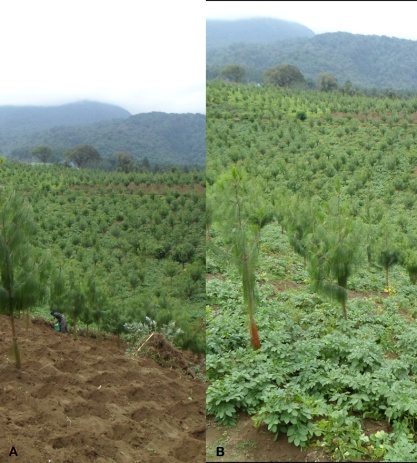 | Figure 1. Typical perspective of taungya. A: A farmer planting crops in a forest plantation; B: A well established annual crop in a forest plantation |
 | Figure 2. Checking out tree species that can readily be affected by farmers’ practices in the plantation |
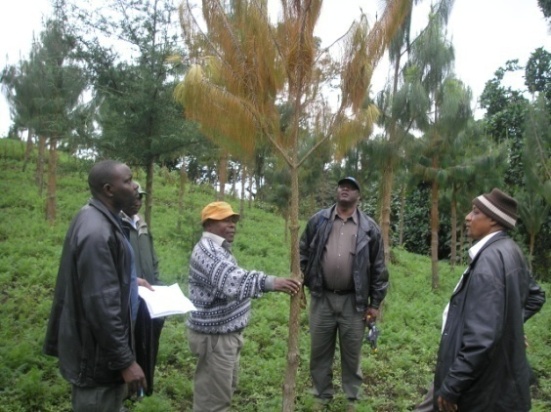 | Figure 3. Finding if some of the existing tree health problems can be attributed to taungya |
4. Results
- Out of the three plantations visited, Meru forest plantation was found to be the most affected in as far as taungya was concerned. The effect was in terms of number of localities where taungya was practiced within the plantation and size of the individual farm lots; extent of damage caused on trees that owe to taungya; and the scope of encroachment into the plantations for farming and social conflicts thereof. So it was agreed that the study is narrowed down to cover Meru plantation alone. The prominent crops associated with taungya in Meru plantation were potato, maize, beans and carrots, mostly grown on the flat (Figure 4).
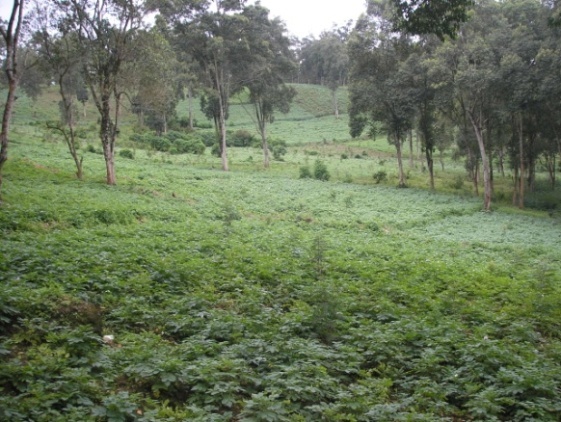 | Figure 4. One of the prominent crops associated with taungya in the plantation is Irish potato |
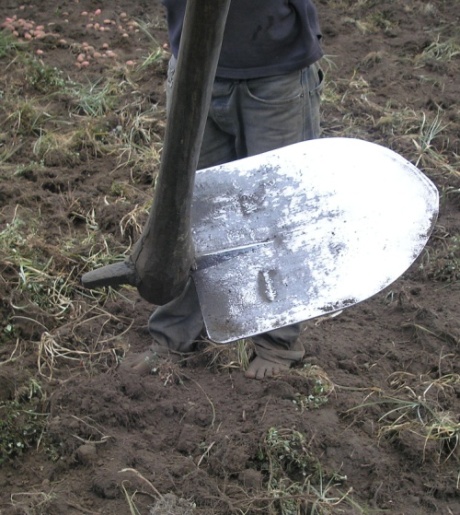 | Figure 5. The hand hoe is the main tool that taungya farmers use |
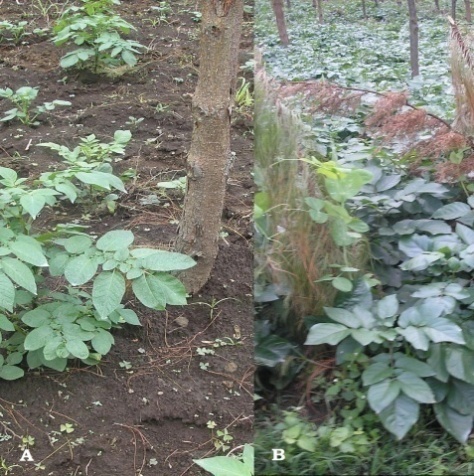 | Figure 6. Taungya practices were associated with heavy use of agrochemicals |
 | Figure 7. Inappropriate disposal of pesticides containers is common in taungya practice |
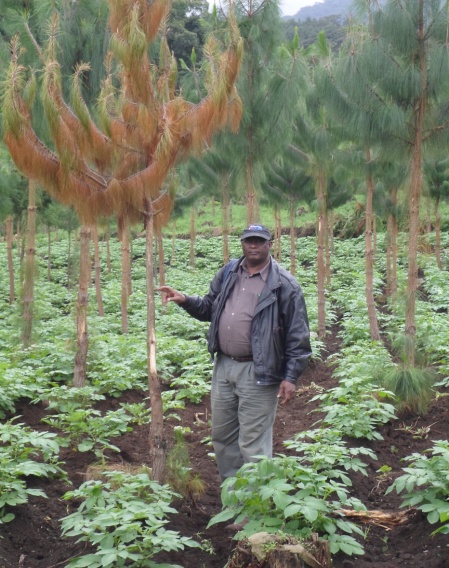 | Figure 9. Damage of forest trees through debarking |
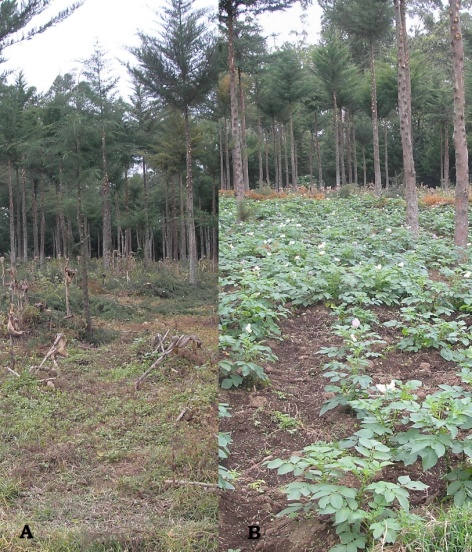 | Figure 10. Damage of trees through over pruning of the trees. A: Field previously planted to maize. B: Over pruning of trees in the field planted to Irish potato |
5. Discussion
5.1. Why Meru Plantation?
- The importance of Meru forest plantation for taungya as compared to the other plantations is thought to be due to human population density. The population densities in the localities where Shume and Sao Hill plantations are situated were not high so the pressure for use of land in the forest plantation for farming has been low. Furthermore, in Shume plantation there are just a few locations in the plantation in which taungya is practiced and it seems because of this, the administration of taungya is easier compared with Meru plantation. So the narrowing of the study to cover Meru plantation alone can be justified.
5.2. Consequences and Prospects of Taungya in Meru Plantation
- The observed problems in the plantation are all a manifestation of taungya. As a practice though, taungya has been a success story in Tanzania until the early nineties [9]. The practice enhanced tree survival, increased food production and reduced costs of forest plantation establishment. Because of these early benefits, taungya was a suitable practice and was recommended. Shortly later, ideas discouraging taungya started to surface in the country [9]. There were increased incidences of sabotage to tree seedlings by farmers; the farmers had more interest in their agricultural crops than the forest trees and there were many incidences of forest land encroachment. Such evils have persisted since then to the present as observed in this study. In the present study, the observed rampant and undue application of agrochemicals is not only a problem to the forest plantation but also to the farmers themselves as workers and as consumers. It is also a threat to biodiversity in the Mount Meru natural system. The agrochemical use is likely to induce the accumulation of chemical residues in the soil, which can eventually limit the choice of trees to be planted. The accumulation of residues in the bodies of consumers can also lead to health problems such as cancer. Furthermore, some of the practices inherent in taungya system as observed in Meru plantation potentially induce conflicts between farming communities and the forest department. The predominant taungya and associated features inevitably leads to sparsely spaced trees and increased cost of tree replacement. There have also been some pieces of evidence of forest land encroachment for farming leaving smaller areas for forest development. Before affirming the ills of taungya in the plantation, case studies of taungya in a few countries are described hereunder.
5.2.1. Lessons from Taungya in Thailand
- In Thailand, a country that neighbors Burma, the destruction of forests through shifting cultivation was a serious problem. More than 10,000 hectares of forest lands were denuded annually by hill tribes and other farmers. Forest village scheme was introduced by the Government and Forest Industry Organization as an attempt to stop further spread of shifting cultivation and deforestation [7]. The forest village system offered hill tribesmen and others who practiced slash and-burn agriculture considerable inducements to settle down. One of principal aims of the scheme was to keep a steady labour force on hand for the long-term needs of forestry, while at the same time providing rural families with an income and other benefits from the kind of farming they choose to practice. The underlying principle of the scheme was to link reforestation with social welfare of the people involved. A systematic programme of public information and the involvement of community leaders was necessary to gain public acceptance of forest villages before they could be started. To achieve the establishment of forest villages, meetings were held with the leaders of hill tribes and other influential individuals. Also, and more important, the families were allowed to grow crops during the first three years of establishment. The families were also provided with free agricultural advice, primary education and medical services. Families who agreed to give up shifting cultivation for settled land use were given tenure of a plot of land to construct a house and develop a 'home garden' where crops could be grown and a few animals (e.g. cows, pigs, chickens and ducks) reared. In return, the farmers were required to help establish and maintain forest plantations. Although the scheme ran well below targets, opportunities had been provided for the people to settle, with long term employment prospects and affording a higher standard of living than previously. The families had abandoned shifting cultivation thus reducing pressure on native forests. Also, through forest villages biodiversity had been improved [11]. Thus, the establishment of forest villages in Thailand concurred with needs of the traditions. The forest village system fitted better into the traditional way of life of shifting cultivators because it allowed the people to move on periodically, clearing new land as they were accustomed to do, but at the same time developing a kind of society in which nomadic life was discouraged. Notwithstanding, numerous weaknesses and constraints of the scheme were identified, which included: setting up of villages with promised facilities required significant expenditure; there was a scarcity of capable managers to oversee the village functions; where forest was still plentiful, ensuring adherence to forest village policy was difficult, and so illegal shifting cultivation continued; some sites were on steep slopes with poor soils thus cultivating crops was hard and yields were low; cash flow problems arose as payments of bonuses were not made until the end of the first year of participation. Furthermore, financial incentives were too low for some, resulting in their leaving to seek work elsewhere.
5.2.2. Taungya in Uganda
- In Uganda, taungya has been practiced for many years. Uganda admits taungya to be a good practice if carried out properly like it was done in Burma. By planting trees with food crops, weed invasion was prevented and soil cover was retained; and through taungya there was a maximum use of land as both crops and trees were grown. Also, employment was provided over a large scale (tree planters and crop growers are all employed); and there was cheaper forest establishment and protection and where leguminous crops were grown, the nitrogen benefitted the trees; yet, and certainly most important, taungya system promoted food security. However, over the past 30 years or so, the results of taungya have been disastrous in terms of the establishment of tree plantations. Farmers faced with the possibility of becoming landless once the trees are fully established often damaged or killed the trees. In some parts of Uganda, farmers severely pruned the trees’ branches to prevent them from shading their crops, thereby extending the period they can use the land for their crops. In some instances, farmers physically uprooted the trees (or partially uprooted to severe some of the roots) to further extend the period they can grow their crops; some instances of heaping weeds on top of saplings had also been recorded. Furthermore, the farmers planted unacceptable crops, such as planting tall crops like maize and sorghum which soon overtopped the trees so weakening and killing them. Several crop species are known to be controversial and are excluded in forest plantations in some countries. Such crops include bananas and plantains (Musa spp), cassava (Manihot utilissima) and sugar cane (Saccharum officinarum). Sugar cane for example, is generally excluded because it is a long-growing crop, so it is feared to deplete the soil and because it casts a heavy shade. Also it is known that allelopathic effects exist in which sugarcane suppresses the growth of trees seedlings [4]. Most taungya problems in Uganda were reportedly to have been caused by lack of adequate supervision. To redress the situation and to ensure equitable access to forest resources, the government of Uganda formulated policies and laws to ensure that communities, especially vulnerable ones participated in decisions that affect their livelihoods. One such policy was that of collaborative forest management (CFM) [6], [20]. CFM is an approach that enhances community participation and development of partnerships for forest management. The purpose of collaborative forest management is to give forest-adjacent communities the opportunity to participate in decision making regarding the management of the forest reserve and enable them receive benefits from the forest and take on some management responsibilities. Organized in forest user groups, community members enter into a memorandum of understanding with the national forestry authority (NFA). In areas where CFM is implemented there is better enforcement of forest rules.
5.2.3. Taungya in Kenya
- In the neighbouring Kenya, taungya system was adopted in 1910 and was referred to as ‘shamba’ system [15], [19]. First introduced as a modified form of the taungya used in South East Asia, the shamba system was a method of forest plantation establishment in which farmers tend tree saplings on state-owned forest land in return for being permitted to intercrop food crops until canopy closure [15], [26]. The shamba system significantly reduced the cost of forest establishment as weeding costs were borne by the farmer. The system also provided significant benefits to farmers in the form of food. In the 1990s the shamba system was often abused and young trees were often neglected or deliberately cut to enable cultivation to continue beyond the usual three-year period. These actions slowed down reforestation progress and resulted in vast areas of land under cultivation within forest reserves. Following these mishaps the system was banned by a presidential decree in 1987, and in the following year all forest residents were evicted from forest areas. The shamba system was subsequently replaced by a modified system referred to as non-residential cultivation (NRC). In the NRC, farmers were integrated into the Forest Department (FD) as resident workers. Under the NRC the farmers were allocated forest plots, still by the name ‘shambas’, but with guaranteed work for nine months per year. The produce from the shambas was considered part of workers´ emolument as they tended the young trees. This (NRC) too was banned after a few years and was being replaced with a redesigned system referred to as the Plantation Establishment and Livelihood Improvement Scheme (PELIS). The scheme was reported to have increased acreage to covers over 8,000 hectares following its implementation.
5.2.4. Taungya in Ghana
- In Ghana, about 75% of her forest plantations were established using taungya system [2]. In the earliest version of taungya that was launched in Ghana in 1930, the farmers had no rights to benefits accruing from the planted trees. Also, the farmers had no decision making role in any aspect of forest management [1], [2]. As a result, the farmers tended to neglect the tree crops since they would not directly benefit when it matured. The farmers also realized that if the tree canopy closed, they would be asked to stop farming to enable the establishment of the tree crop from which they would not benefit. Consequently, most farmers deliberately killed the trees so that they would not be asked to stop farming. Other evils committed by the farmers included clearing more land for plantation development than was needed for the available seedlings; they failed to weed around tree seedlings, thereby retarding their growth so as to extend land-use rights beyond three years; the farmers also illegally farmed other areas of the forest reserves, whether degraded or not. Furthermore, the farmers planted food crops that were not compatible with the tree crops, leading to reduced tree growth [5]. Other problems included lack of supervision by the Forestry Department; inadequate financing mechanisms and abuse of power by public officials, especially in farm allocations. As a result, the system was suspended in 1984. Following these observations, the taungya system in Ghana was revised in 2002 to make it self-financing and sustainable and partly to provide employment and alleviate poverty in the rural communities. Initiated by the government with support from FAO and the World Bank, the modification entailed a consultation process involving stakeholder groups, viz. the farmers, landowners, local communities and NGOs. In the new version, the farmers became owners of forest plantation products while the Forestry Commission (FC) and forest edge-communities were shareholders. The stakeholders played different roles in the revised taungya system. The farmers provided labour, did pruning and maintenance and tending of the forest plantings; the forest commission provided technical expertise, farmer training, provision of equipment and tools, stock inventory and marketing of the forest products; the landowners contributed land while the forest adjacent communities provided the services of protecting the investment from fire. The consultation process devised an equitable benefit sharing framework based on contribution of the participants. These levels of contribution together with stakeholder expectations led to the following benefit sharing framework: the farmers get 40% of timber benefits; the forest commission gets 40%; the land owners get 15% while the forest adjacent communities get 5% of the benefits accruing from the modified taungya system. The consultation also recommended specific policy and legislative reforms to strengthen tenure and resource rights, especially for the disadvantaged groups such as nursery operators. For Ghana’s modified taungya system the general consensus had been that in order for the system to be sustainable there should be a continuous flow of benefits to participating farmers after harvest of food crops at the end of third year and, there should be some bulk payment at the time of harvesting logs.
5.3. Taungya Situation in Meru Plantation in Relation to the Case Studies
- The preliminary survey carried out in Meru plantation vis-à-vis taungya revealed several issues. First, much of the problems found in other countries that had adopted the system, were also observed in Meru plantation as described in the results section. For example, the severe pruning of trees by farmers in Uganda to prevent the trees from shading their crops was also observed in Meru plantation. Second, the taungya system practiced in Meru plantation resembled the earliest forms of the same in Kenya and Ghana. Surely, the taungya system observed in Meru plantation is precisely what was referred to as shamba system in Kenya, which had already been banned in the country since 1987. Also, the taungya system practiced in Meru plantation resembles the earliest version of taungya in Ghana. In Ghana’s taungya farmers had no right to benefits accruing from planted trees; farmers had no decision making role in any aspect of forest management; and there was inadequate supervision by forest officials, which resulted into neglect of the trees by farmers and deliberately killing trees. All this sums up to the attestation that Tanzania lags behind in terms of evaluating and improving taungya as it is practiced in her plantations, particularly Meru forest plantation. Well, the taungya system practiced in the plantation is not exactly the form that had been practiced in Burma. However, even with the minor improvement, the Meru forest plantation is still using the shamba style which Kenya had abolished in 1987 replacing it with non-residential cultivation, which was still later replaced by the Plantation Establishment and Livelihood Improvement Scheme. Also, the taungya practiced in Meru plantation is still the form of taungya which Ghana had abolished in 1984.
5.4. The Need for Modification
- The countries in the case studies described in this paper (Thailand, Ghana, Kenya and Uganda) had learned the ill effects of taungya. Considering its benefits on the other side, they did not abandon the system but opted to improve it. And following the improvement, the forests had good quality stand in terms of stocking rate, straight boles and few weeds [12]. This was for example, because of high commitment of participating farmers after canopy closure, i.e. taungya farmers continued to tend the trees until maturity. Also, the tree stand was of good quality because there were regular visits by forest field officers during plot establishment. Further, there had been a bumper harvest achieved by the farmers during the year especially for plantain and maize [21]. Taungya requires socially acceptable arrangements to ensure security of land tenure and effective land allocation system. In fact, one of the factors causing excessive forest destruction is precisely the lack of cooperation from the society. It can be adopted that as long as there is pressure on land as it is in Northern Tanzania where Meru plantation is taungya will always be there and will always cause socioeconomic problems. Considering the social hurdles, which Tanzania’s forest department experiences with taungya, especially for the Meru plantation it is highly recommended that the present approach is reviewed. The approach should preferably be transformed into what is referred to as adaptive co-management and adaptive governance as suggested by [23]. This is touted as the highest level of taungya management for win-win situation between government and local communities.Justification for the recommendation is that the present values and preferences of the poor local people typically contrast with those supposed for them by professionals, such as the forest managers. It is believed [8] it is possible to make the local people manage greater complexity in their localities provided the present normal dominance is relaxed or at best reversed. The situation in Meru plantation can be improved if the forestry department administrators change their behavior and attitude towards the adjacent communities. At its simplest it will require the professionals to become facilitators – sitting down, respecting and listening to the locals, not interrupting or looking at them as mere trouble makers. This will enable the local people begin to stand up and start showing that they can do. The implementation of this approach will partly be viewed as corporate social responsibility by the government to the communities with whom the plantation landscape is shared.Furthermore, modification of the taungya system to allow communities to take part will strengthen local government services to its subjects. Improving taungya by enabling communities to participate in forest management will ensure that local governments also receive benefits from forest management for funding local development activities such as roads, schools and health centers. In this way, there will be twin ways of fighting rural poverty and hunger, like the way medical practitioners fight serious skin rashes by recommending both oral and topical medications. The proposed approach will enable local communities attain reliable tenure of land to grow crops. Meanwhile, by supporting the local governments it enhances their capacity to fund development locally, which is yet another way of fighting poverty. One opportunity for executing modification of taungya system exists – the forest officials, at least those working in Meru plantation have since realized the present taungya set up in the plantation is causing problems when it comes to planning for enhancing plantation productivity.
5.5. How can the Modification be Achieved?
- As shown in the country case studies, different prototypes of taungya exist across different landscapes and so, Tanzania can choose one. It may decide to blend any combination of the case studies to suit its peculiar situation and ambitions; or it may even have a sort of modified taungya, which did not occur in any other country. What is important is to do away with all or even part of the existing taungya problems and improve forest plantation productivity and at the same time restore the social density of communities in the periphery of the plantations. From what has been covered by this study, the strategic approach to achieve the proposed modification is perhaps clear: first, re-identify and analyze the key taungya-based problems that have haunted the forest department for years; second, consult the farming communities to seek views on the preferred situation regarding use of forest land for farming; third, choose an approach for modification that fits better with ambitions of the forest department and with needs of the traditions of the adjacent communities; fourth, choose what the forest department is willing to offer or sacrifice to the communities to achieve the most sustainable modification; fifth, evaluate the present management capacity as well as cost-benefit analysis regarding the proposed modification; and finally, engage into a consultative process involving all stakeholder groups, such as the farmers, village governments, local government authorities to which the villages belong and NGOs/private sector organizations so as to operationalize the modification process.
6. Conclusions
- In the context of rural development which is an important pillar to food security and poverty reduction, taungya is a friend and foe. It simplifies the establishment of forests in terms of costs while also enhancing food security and improve livelihood of communities residing adjacent to the plantation. Taungya is a foe when the smallholder farmers practice it with inadequate government supervision where it becomes disastrous against the hope and promise of sustainable forest plantations establishment and management. For years now, the productivity of Meru plantation has not been up to the existing potential due to taungya practice. Also, the people dwelling in areas adjacent to the plantation are known to heavily depend on the plantation for livelihood through taungya to the extent that they cannot do without it. Thus, in order to harness the best from taungya system and acknowledge the role of government in its operations, there is an apt need to modify the manner in which it is practiced and in the way the benefits are shared. The terms used in leasing forestland to farmers for taungya need to be revisited. The terms should also be regularly reviewed to realign them with ambitions of the forest department and with those of the local farming communities.
ACKNOWLEDGEMENTS
- The authors wish to thank the Tanzania Forest Fund, which through the Tanzania Forest Research Institute (TAFORI) supported the work of the Forest Health Forum that led to the generation of this information. The staffs working in the visited plantations are acknowledged for the provision of valuable information about taungya in their places of work. Thanks to the management of Meru, Shume and Sao Hill forest plantations for allowing the team into the plantations.
 Abstract
Abstract Reference
Reference Full-Text PDF
Full-Text PDF Full-text HTML
Full-text HTML